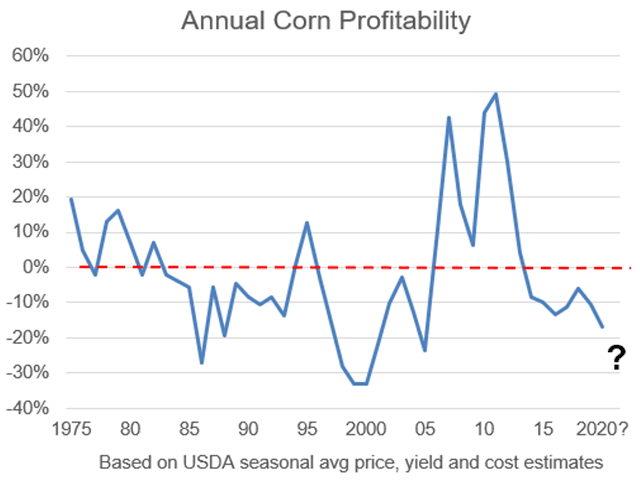Todd's Take
A Second Look at the Year 2000
Back in December 2019, I wrote "A Hunch About This Market Cycle" (see https://www.dtnpf.com/…), which found similarities with the year 2000 to the depressed predicament ag prices found themselves in at the end of 2019.
One of the lessons was that we had seen a similar time before when ag prices were depressed and financial markets were highly popular. The extreme divergence between the two was unlikely to last. It was encouraging that, early in 2020, prospects looked better for global ag demand and talk of a new phase-one trade agreement with China had bullish possibilities. Just maybe we were at a turning point.
Of course, the turning point never came as whatever hope U.S. ag had for increased demand was quickly shut down by a global pandemic. The year 2000 had a lot of bearish influences, including an Asian recession, but a global pandemic was not one of them.
In trying to understand the effect of coronavirus on ag markets, I have been asked if there were any previous years to compare 2020 to. My early response was no, we have not seen anything like this in our lifetimes and it's difficult to think of any prior year that compares.
However, after doing some recent research on corn and soybean profitability, I have to say that there is reason to keep talking about the comparison with the year 2000. No, 2000 did not experience anything like COVID-19, but the assault on producers' bottom lines was severe, probably even more severe than we'll see in 2020.
P[L1] D[0x0] M[300x250] OOP[F] ADUNIT[] T[]
It may sound surprising at first to hear that financial losses in percentage terms were worse in 2000 than what producers are facing today, but at least that is what USDA's numbers claim. In 2000-01, USDA estimated producers grossed $253.27 an acre (136.9-bushel yield times an average farm price of $1.85 per bushel), 33% short of the $378.32 it cost to produce an acre of corn.
I understand all farming is local and each situation is different. Quality of land, yield potential, availability of demand choices, access to irrigation and the part of the country you live in all play important parts in how the numbers turn out. However, if we accept USDA's estimates as a representation of the national average, the 2000 experience equates to an average farm price of $2.58 per bushel in 2020-21.
USDA's current estimate of the average farm price in 2020-21 is $3.20 per bushel, and frankly, unless dry weather takes a significant cut out of this year's crop, $3.20 is too high. USDA's current ending stocks-to-use estimate of 22% is apt to drop a few percentage points in the July World Agricultural Supply and Demand Estimates (WASDE) report on Friday, July 10, but even a few points lower still points to cash prices below $3.00.
Back to the comparison with 2000, cash corn prices may indeed drop to $2.58 per bushel if the autumn harvest goes well, but that low of a farm price average for all of 2020-21 seems highly unlikely, even in the year of the coronavirus.
Barring significant weather disruption, both 2000 and 2020 are likely to go down as long-term bearish troughs in the history of corn prices, but why shouldn't 2020 be the financially more painful of the two? After all, a global pandemic and the 4.9% contraction in the world economy as estimated by the International Monetary Fund are pretty severe hits.
Part of the answer is that the most extreme economic response to the global pandemic took place in the corn season of 2019-20. Unless the economy has to shut down again, 2020-21 is more likely to suffer aftershocks.
Also, the world economy is more prosperous in 2020 than it was in 2000, especially among Asian nations. Even with the coronavirus, USDA is estimating a world corn demand growth of 3.8% in 2020-21 versus world growth of just 0.01% in 2000-01.
Just the fact that 2020 probably won't be as financially severe as things were in 2000 is little consolation to today's producers. The larger point is that times this extreme tend to stand out as long-term lows and serve as reminders as to how bad things can get.
In the meantime, thank goodness for crop insurance and USDA farm programs:
Catastrophic hits to demand and good weather creating big crop surpluses are out of grain producers' control, and years like 2000 and 2020 are what those programs were made for.
Todd Hultman can be reached at Todd.Hultman@dtn.com
Follow him on Twitter @ToddHultman
(c) Copyright 2020 DTN, LLC. All rights reserved.




